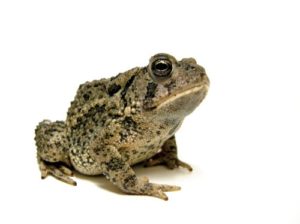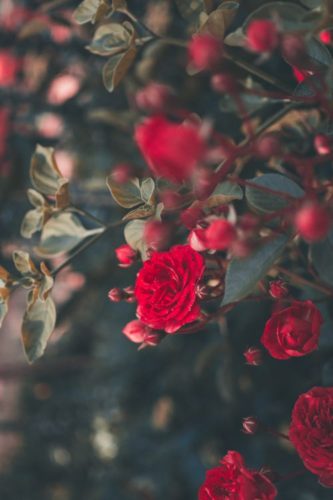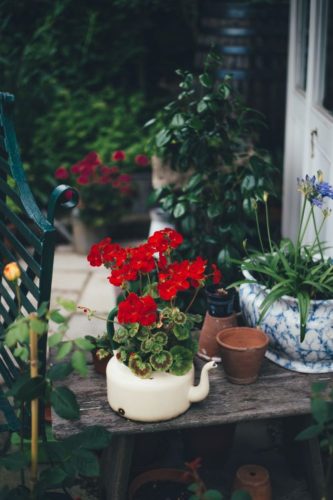
“Ne’er cast a clout ’til May is out,” is an old English saying that means do not put away your long johns until May is over — well, we certainly have had a few very cool nights recently, which is just wonderful, allowing one to sleep with the windows open.
I cannot remember the last time we had a real spring like the one we are experiencing this year, with plenty of rain. May is typically a dry month, although with the effects of global warming, no weather is typical these days. However, this beneficial rain is wonderful for all the spring plant growth happening in the beginning of the growing season.
I am so in awe of the miracle of Mother Nature; the symbiotic relationship between plants and others of God’s creatures. As I look out of my window into my field, I can see the buds opening on my long stand of peonies; which brings to mind one of those relationships — the friendly partnership between ants and peonies.
PEONIES & ANTS:

I am often asked “Maureen, should I worry about ants on my peonies?” The answer is “That’s not a problem, lots of ants on the peonies just demonstrate that you have healthy plants with big buds producing more nectar and therefore attracting the ants.”
Make sure Peonies get plenty of water and after blooming, apply a light dose of organic 5-10-5 fertilizer and check the soils PH, which should be between 6.5 and 7.0. It is hard to ruin a good peony border but you can err in the fertilizing process, so go easy on the organic aged manure (never thought I would say that) and just give a light dose of fertilizer, and to reiterate, apply the fertilizer after blooming.
At the beginning of June, I pinch off the side buds on my large stand of peonies, this ensures big blooms on the rest of the plant.
ANTS:
On the subject of ants; if you see them “let them live,” because often their presence indicates that we have aphids around and ants feed off aphids; they are very useful creatures.

TOADS:
Another very useful creature in the pest wars is the lowly toad so I always put out some toad houses (which you can purchase from the garden center) around and about in your borders. You can also use an old clay pot that is cracked and make sure that the crack is two to three inches wide for the door so the toad can enter. Also put a small saucer as a floor under the pot with some rocks, which you keep damp, so that your friendly bad-bug eater has his or her ideal home environment.
MULCH:
Mulch your gardens in June; when the ground has warmed up to about 45 or 50 degrees. When you mulch be careful mulching around trees; do not get the mulch any closer than four inches from the trunk, as any closer it can promote rot and disease in the tree itself.
Also trees that are mulched too deeply near the trunk invite mice and other rodents to come and nest and gnaw on the trunk.
The garden as a whole can be mulched to a depth of between two and three inches. I prefer fine hardwood mulch in the dark brown color but no dyed red mulch please; keep the garden looking natural and not like a Disney theme park.
ROSES:

June is the month when roses begin to bloom. I prefer David Austin roses that I find are the most trouble-free roses, repeat bloomers and have wonderful fragrances.
Some of my favorites are A Shropshire Lad, a soft peachy pink, Abraham Darby with blooms in apricot to yellow, Fair Bianca a pure white, Heritage, a soft clear pink and my favorite Evelyn, which has giant apricot flowers in a saucer shape and the fragrance is second to none with a luscious fruity tone, reminding me of fresh peaches and apricots.
Feed your roses with an organic rose food called Roses Alive, which you can obtain from Gardens Alive on the internet, feed them once a month until mid-August, then stop feeding so they can go into a slow dormancy.
Japanese beetles are very attracted to roses; so any Japanese beetle traps should be placed far away from your borders on the perimeter of the property. Or check TheEnglishLady.com on the Organic Products page for other solutions to the beetles and other unwanted pests.
A tip for keeping cut roses fresh: cut the roses in the morning before 10 a.m., just above a five leaf cluster and place stems in a container of lukewarm water. Inside the house, re-cut the stems under warm running water, forming a one and a half inch angular cut, then place in a vase filled with warm water. Do not remove the thorns on cut roses, which I have found reduces their indoor life by as much as three days.
HYDRANGEAS:
Need plenty of water, (in the fields they were originally found close to water being a wetland plant before they were introduced into our gardens), organic aged manure, good ventilation, organic fertilizer and full sun.
WISTERIA:
Regular pruning through spring and summer is the main factor to help this arrogant vine to flower; by that I mean, several times during the season. Prune every two weeks at least six inches on each stem.
CLEMATIS WILT:
If you have this problem with a clematis, you notice it early because the shoots wilt and die. Unfortunately this disease is impossible to cure, as it is soil-borne. Therefore you cannot plant another clematis of that species in that area but you can plant the Viticella clematis selection; these are vigorous, free-flowering blooms and are not susceptible to wilt. Some good choices in this variety are Blue Belle, Etoile Violette, both are purple and Huldine, which is a white,
CONTAINER GARDENS:

If you have room for one pot, you have room for a number; placed close together in different shapes and sizes, they create your own miniature garden.
Apart from regular pots, the most unexpected objects make really interesting containers. A friend who cut down trees this past winter, left the stumps and hollowed them out to make containers, one large and two smaller stumps together, a really interesting combo.
At the same time, look in your basement, shed or barn to see if you have an old wheelbarrow, even if it has a wheel missing it will present an unusual angle as a planter. Or you may come across a large chipped ceramic jar I– have an old, two-foot-tall, ceramic vinegar container, replete with a hole where the vinegar tap was inserted (ideal for drainage), which will look great on my newly-painted blue bench next to my red milk shed!
LAWN CARE:
Do not forget to add organic grub control through July, so that you keep down the mole infestation; remember no grubs means less food for the moles.
POWDERY MILDEW:
Keep an eye open for powdery mildew, especially after rain when the humidity returns.
In a sprayer, mix two tablespoons of baking soda, two tablespoons of vegetable or horticultural oil in a gallon of water and spray the mildew. Summer phlox is particularly prone to this affliction; I recommend Phlox Miss Lingard or Phlox David, white ones of the species, these are the most mildew-resistant.
Monarda, commonly known as Bee Balm, is also affected by the mildew; the one I have found to be the most resistant is Cambridge Scarlet. Do be careful when introducing Monarda into the garden; they, along with Purple Loosestrife and Evening Primrose, are extremely invasive and can take over your entire border.
On the subject of invasive plants; if you plant mint; plant it only in containers, otherwise mint will spread throughout your borders.
I hope these tips are useful to you in this busy time of year in the garden and I’ll see you on LymeLine next month!